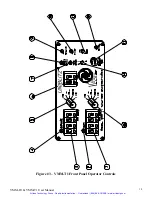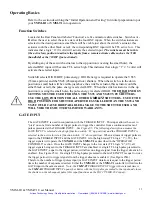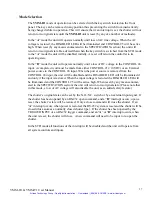
RS-232C Operation
Both the
VMM-D1
and the
VMM-T1
inputs can be controlled via an RS-232C computer
serial signal (COM port). From your computer's RS-232C serial port connect a cable (such as
the
9l0RS
cable, the
9l0RSDC
cable,
a null modem cable
, or a user-constructed cable with connections as enumerated in the INPUT
SPECIFICATIONS) to your unit's RS-232C interface. Connect the Tx (transmit) from the host
to the Rx (receive) on the
VMM-T1
or
VMM-D1
control unit. All other lines should have the
same pin out (from the host) provided the host uses a 9-Pin D-sub connector. If the host
contains a 25-Pin D-sub or an 8-Pin Mini-DIN, check your computer's user's manual to find the
proper corresponding pin outs. In most cases the corresponding 25-Pin D-Sub pin out and
MAC 8-Pin Mini-DIN are as follows:
Function
VMM
IBM IBM MAC
DB-9F
DB-9M
DB-25M
Mini-DIN-8F
Rx
Receive
Data
Pin 2
Pin 2
Pin 3
Pin 5
Tx
Transmit Data
Pin 3
Pin 3
Pin 2
Pin 3
GND
Signal Ground
Pin 5
Pin 5
Pin 7
Pin 4
DSR
Data Set Ready
Pin 6
Pin 6
Pin 6
N/C
RTS
Request to Send
Pin 7
Pin 7
Pin 4
Pin 1
CTS
Clear to Send
Pin 8
Pin 8
Pin 5
Pin 2
All other pins not used. Be sure to connect the Tx pin, Pin 3 from the IBM 9-Pin D-Sub (or Pin
2 from the 25-Pin D-Sub) male connector to the Rx pin, Pin 2 of the
VMM-T1
or
VMM-D1
9-
Pin D-Sub female connector (located at the rear panel) for proper operation. Connect all other
functions by type as indicated above.
By sending the proper commands, the unit will respond by activating the proper function. The
program listed on page 31 will allow operation of the
VMM-T1
or
VMM-D1
from the
computer keyboard.
With activation of the shutter with a trigger command through the RS-232 interface, a reset
command from the control unit's front panel, through the RESET INPUT on the rear panel, a
reset command through the RS-232, or a subsequent trigger command from the RS-232 will
deactivate the shutter, (
VMM-D1
only).
When an open command is sent to either controller,
a reset command will
not
close the shutter. The shutter must be closed with a close command.
The
VMM-T1
controller trigger command from the RS-232 is utilized to trigger the built in
timers.
Up to eight
VMM-D1
or
VMM-T1
can be daisy chained together (connected through the same
serial port) using the
910RSDC
cable. One of these daisy chain cables is required for each
controller in the chain. See Figure #6. Figure #6 illustrates connecting two controllers from a
single serial port. Once connected, each unit will require a unique address in the chain. This is
accomplished by adjusting the octal switch beneath the 9-Pin D-sub connector on the rear
panel to the desired command range. (See “ADDRESS Select” under GENERAL
CHARACTERISTICS in the SPECIFICATIONS section for a complete listing of the
command range for each octal switch position.) The specific command range sent will decode
commands sent via the serial port. A set of “ALL” commands is also available to control all
units connected to the serial port.
VMM-D1 & VMM-T1 User Manual
28
Artisan Technology Group - Quality Instrumentation ... Guaranteed | (888) 88-SOURCE | www.artisantg.com
















































